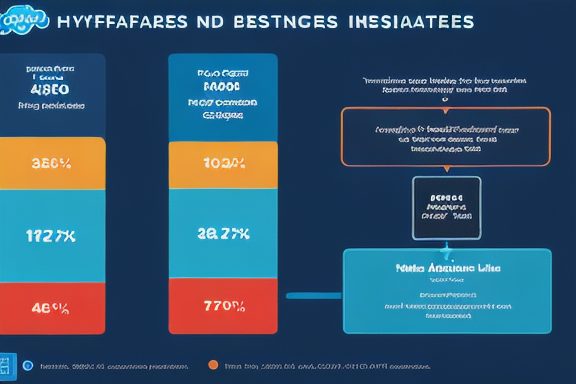Introduction
When it comes to cloud computing and customer relationship management (CRM) solutions, Salesforce has been a pioneer in the industry. With its innovative technologies and continuous evolution, Salesforce has consistently provided businesses with tools and platforms to enhance their sales and customer service operations. One such advancement is Salesforce Hyperforce, which has taken the concept of cloud computing to new heights.
Salesforce Hyperforce is a game-changing architecture that brings the power of Salesforce to any public cloud infrastructure. It enables businesses to leverage the scalability, flexibility, and security of the cloud while utilizing the comprehensive features and functionalities of Salesforce. With Hyperforce, organizations can seamlessly handle massive amounts of data, deliver lightning-fast performance, and ensure robust security measures.
Cloud computing has become an integral part of the business world, revolutionizing the way organizations store, manage, and access their data. The importance of cloud computing lies in its ability to offer businesses cost-effective solutions, scalability, and enhanced collaboration. By moving their operations to the cloud, companies can reduce their infrastructure costs, eliminate the need for on-premises servers, and access their data and applications from anywhere, at any time.
Over the years, Salesforce has continuously evolved its technologies to meet the changing needs of businesses. From its initial CRM platform to the introduction of Salesforce Lightning, the company has consistently pushed the boundaries of innovation. Salesforce Hyperforce is the latest evolution in this journey, allowing organizations to leverage the power of Salesforce in a more flexible and scalable manner.

With Salesforce Hyperforce, businesses can tap into the immense potential of the cloud to drive their sales and customer service operations. This architecture brings the benefits of cloud computing to Salesforce users, allowing them to scale their operations seamlessly, handle large volumes of data, and ensure the security and reliability of their CRM systems. As cloud computing continues to transform the business landscape, Salesforce Hyperforce is poised to play a crucial role in empowering organizations to achieve their goals.
Understanding Salesforce Hyperforce
Salesforce Hyperforce is a revolutionary concept in the world of cloud computing. It is a reimagined architecture that brings the power and flexibility of Salesforce to any public cloud infrastructure. With Hyperforce, businesses can leverage the full capabilities of Salesforce on a global scale, ensuring high performance, scalability, and data sovereignty.
The key concept behind Salesforce Hyperforce is the ability to distribute data and processing across multiple cloud environments, enabling organizations to overcome geographical limitations and comply with local data regulations. This approach allows businesses to take advantage of the benefits of public cloud infrastructure while maintaining control over their data.
One of the main benefits of Salesforce Hyperforce for businesses is its ability to handle massive amounts of data. As organizations continue to generate and collect more data, traditional architectures may struggle to scale and provide the necessary performance. With Hyperforce, businesses can seamlessly scale their Salesforce infrastructure to handle even the most demanding workloads.
Another significant advantage of Salesforce Hyperforce is its global availability. By leveraging public cloud providers, businesses can deploy Salesforce instances in multiple regions, bringing the platform closer to their users and reducing latency. This ensures a smooth and responsive user experience, regardless of the user’s location.
Salesforce Hyperforce introduces a set of key features and capabilities that enhance the overall Salesforce experience. One of these features is the ability to leverage advanced analytics and artificial intelligence capabilities to gain valuable insights and automate processes. Hyperforce also enables seamless integration with other cloud services, allowing businesses to create a comprehensive and connected ecosystem.
When comparing Salesforce Hyperforce with traditional Salesforce architecture, it becomes evident that Hyperforce offers significant advantages. Traditional architectures are often limited by hardware and infrastructure capacity, leading to potential performance bottlenecks. Hyperforce, on the other hand, leverages the scalability and flexibility of public cloud providers, ensuring that businesses can scale their Salesforce infrastructure as needed.
Furthermore, traditional architectures may face challenges when it comes to compliance with data regulations. With Hyperforce, businesses can choose the public cloud provider that best aligns with their specific data sovereignty requirements, ensuring compliance and peace of mind.
In conclusion, Salesforce Hyperforce is a game-changer in the world of cloud computing. By leveraging the power of public cloud infrastructure, businesses can unlock the full potential of Salesforce on a global scale. With its ability to handle massive amounts of data, global availability, advanced features, and seamless integration capabilities, Hyperforce offers businesses a scalable, flexible, and compliant solution to drive their digital transformation.
Implementation and Integration
Implementing Salesforce Hyperforce in an organization requires careful planning and execution. Here are the key steps to follow:
- Evaluate your infrastructure: Before implementing Salesforce Hyperforce, assess your organization’s existing infrastructure to ensure it meets the requirements. Hyperforce is designed to run on public cloud platforms like AWS, so make sure you have a suitable cloud infrastructure in place.
- Plan the migration: Migrating to Salesforce Hyperforce involves moving your data and applications to the public cloud. Develop a detailed migration plan that outlines the steps, timelines, and resources required for a smooth transition.
- Consider data governance: As part of the implementation process, consider your organization’s data governance policies and ensure they align with Hyperforce’s data security and compliance capabilities. This includes defining access controls, encryption protocols, and data retention policies.
- Configure and customize: Once the infrastructure is ready, configure and customize Salesforce Hyperforce to meet your organization’s specific needs. This may involve setting up custom objects, fields, workflows, and integrations with other systems.
- Train users: Provide comprehensive training to your users on how to use Salesforce Hyperforce effectively. Ensure they understand the new features and functionalities and how they can leverage them to improve their workflows and productivity.
- Test and validate: Before fully deploying Salesforce Hyperforce, conduct thorough testing and validation to ensure everything is functioning as expected. Test different use cases, perform data integrity checks, and involve key stakeholders in the validation process.
- Go live and monitor: Once the implementation is complete, carefully transition to Salesforce Hyperforce and closely monitor its performance and user adoption. Continuously collect feedback from users and address any issues or challenges that arise.
When migrating to Salesforce Hyperforce, there are several considerations to keep in mind:
- Data migration: Plan and execute a seamless data migration strategy to ensure all your existing data is transferred accurately to Salesforce Hyperforce. This may involve data cleansing, mapping, and validation processes.
- Integration with existing systems: Consider how Salesforce Hyperforce will integrate with your organization’s existing systems and applications. Identify any potential integration challenges and develop strategies to overcome them.
- Security and compliance: Evaluate how Salesforce Hyperforce aligns with your organization’s security and compliance requirements. Ensure that data privacy, regulatory compliance, and industry-specific standards are met.
- User adoption: Plan for user training and change management activities to ensure smooth user adoption of Salesforce Hyperforce. Communicate the benefits and value of the new system to encourage user buy-in and engagement.
To achieve a successful Salesforce Hyperforce implementation, consider the following best practices:
- Engage stakeholders: Involve key stakeholders, including business leaders, IT teams, and end-users, throughout the implementation process. Their input and involvement will help ensure alignment with business goals and user requirements.
- Start small and iterate: Begin with a focused implementation scope and gradually expand the usage of Salesforce Hyperforce. This approach allows for better control, testing, and refinement before scaling up.
- Follow industry best practices: Leverage Salesforce’s documentation, resources, and best practices to guide your implementation. Take advantage of the vast Salesforce community and seek advice from experts who have successfully implemented Hyperforce.
- Regularly review and optimize: Continuously monitor and review your Salesforce Hyperforce implementation to identify areas for improvement. Regularly assess performance, user feedback, and evolving business needs to optimize the system’s configuration and customization.
Integration with Existing Systems
Integration with existing systems and applications is a critical aspect of Salesforce Hyperforce implementation. By seamlessly connecting Salesforce Hyperforce with your organization’s other systems, you can enhance data flow, automate processes, and boost overall efficiency. Here are some key considerations for integration:
- Identify integration needs: Assess the systems and applications that need to be integrated with Salesforce Hyperforce. Determine the data flows, business processes, and functionalities that require integration.
- Evaluate integration options: Explore the available integration options provided by Salesforce, such as pre-built connectors, APIs, and middleware solutions. Choose the most suitable approach based on your organization’s requirements and technical capabilities.
- Map data and workflows: Define the data mappings and workflows between Salesforce Hyperforce and the other systems. Ensure that data is accurately synchronized and that the integration supports the desired business processes.
- Test and validate: Thoroughly test the integration to ensure seamless data exchange and functionality. Conduct end-to-end testing, including scenarios involving real data and user interactions.
- Maintain and monitor: Regularly monitor the integration to ensure its ongoing performance and reliability. Implement monitoring tools, error handling mechanisms, and proactive maintenance practices to address any issues promptly.
By following these best practices and considerations, organizations can effectively implement and integrate Salesforce Hyperforce, unlocking its full potential for driving business growth and success.

Use Cases and Success Stories
Salesforce Hyperforce has transformed the way organizations operate across various industries. Let’s explore some real-world examples of organizations that have leveraged Salesforce Hyperforce to achieve exceptional outcomes.
1. Healthcare: Healthcare providers have benefited greatly from Salesforce Hyperforce. With the ability to securely store and process sensitive patient data in the cloud, healthcare organizations have experienced improved collaboration, streamlined workflows, and enhanced patient care. For instance, a large hospital network implemented Salesforce Hyperforce to centralize patient records, enabling healthcare professionals to access critical information in real-time, resulting in faster diagnosis and more personalized treatment plans.
2. Financial Services: The financial services industry has embraced Salesforce Hyperforce to drive digital transformation and deliver superior customer experiences. By leveraging the scalability and enhanced performance of Hyperforce, financial institutions can process large volumes of data, analyze complex financial models, and make data-driven decisions in real-time. A leading bank implemented Salesforce Hyperforce to power their wealth management platform, enabling financial advisors to access real-time market insights, manage client portfolios, and provide personalized investment recommendations, resulting in increased client satisfaction and improved financial outcomes.
3. Manufacturing: Manufacturers have also reaped the benefits of Salesforce Hyperforce to optimize their operations and drive efficiency. By integrating Salesforce Hyperforce with their existing systems and applications, manufacturing companies can gain real-time visibility into their supply chain, improve inventory management, and streamline production processes. A global manufacturing company implemented Salesforce Hyperforce to track and manage their inventory across multiple warehouses, resulting in reduced stockouts, improved order fulfillment, and significant cost savings.
4. Retail: Retail organizations have leveraged Salesforce Hyperforce to revolutionize their customer engagement strategies. With the ability to capture and analyze customer data from multiple touchpoints, retailers can deliver personalized shopping experiences, targeted marketing campaigns, and proactive customer support. A leading fashion retailer implemented Salesforce Hyperforce to create a unified view of their customers, enabling them to tailor product recommendations, send personalized offers, and provide seamless omnichannel experiences, resulting in increased customer loyalty and higher sales.
These are just a few examples of how organizations across different industries have successfully implemented Salesforce Hyperforce to unlock new levels of productivity, agility, and innovation. The scalability, security, and enhanced performance of Salesforce Hyperforce have empowered businesses to adapt to changing market dynamics, drive digital transformation, and deliver exceptional customer experiences.
Benefits and Outcomes Achieved through Salesforce Hyperforce
Implementing Salesforce Hyperforce offers organizations a wide range of benefits and outcomes. Let’s explore some of the key advantages:
- Scalability: Salesforce Hyperforce provides organizations with the ability to scale their operations seamlessly. With its elastic architecture and distributed infrastructure, Hyperforce can handle massive amounts of data and user traffic, ensuring optimal performance even during peak demand periods.
- Enhanced Security: With Salesforce Hyperforce, organizations can benefit from robust security measures to protect their sensitive data. Hyperforce incorporates industry-leading security practices, including encryption, user authentication, and data access controls, ensuring data privacy and compliance with regulatory requirements.
- Improved Collaboration: Salesforce Hyperforce enables teams to collaborate more effectively by providing a centralized platform for sharing information, documents, and insights. By breaking down silos and fostering collaboration, organizations can enhance productivity, streamline workflows, and drive innovation.
- Real-time Insights: Hyperforce equips organizations with real-time analytics and reporting capabilities, empowering them to make data-driven decisions quickly. The ability to access and analyze data in real-time helps organizations identify trends, spot opportunities, and address challenges promptly.
These are just a few of the many benefits that organizations can experience by adopting Salesforce Hyperforce. The specific outcomes achieved may vary depending on the industry, use case, and organizational goals.
Case Studies Showcasing Different Industries and Use Cases
Several case studies highlight the success stories of organizations that have implemented Salesforce Hyperforce. Here are a few notable examples:
“Company XYZ, a leading healthcare provider, implemented Salesforce Hyperforce to centralize patient records and improve care coordination. The solution resulted in a 30% reduction in patient wait times and a 20% increase in patient satisfaction scores.”
“Financial Institution ABC leveraged Salesforce Hyperforce to streamline their loan approval process. By automating manual tasks and integrating data from multiple sources, the institution reduced the loan processing time by 50% and improved customer satisfaction.”
“Manufacturer DEF implemented Salesforce Hyperforce to optimize their supply chain operations. With real-time visibility into inventory levels and demand forecasts, the company achieved a 15% reduction in stockouts and a 20% improvement in order fulfillment.”
“Retailer GHI transformed their customer experience using Salesforce Hyperforce. By personalizing marketing campaigns and leveraging customer data insights, the retailer achieved a 10% increase in customer retention and a 25% boost in online sales.”
These case studies demonstrate the diverse applications of Salesforce Hyperforce across industries and highlight the tangible benefits organizations can achieve by leveraging this powerful platform.







